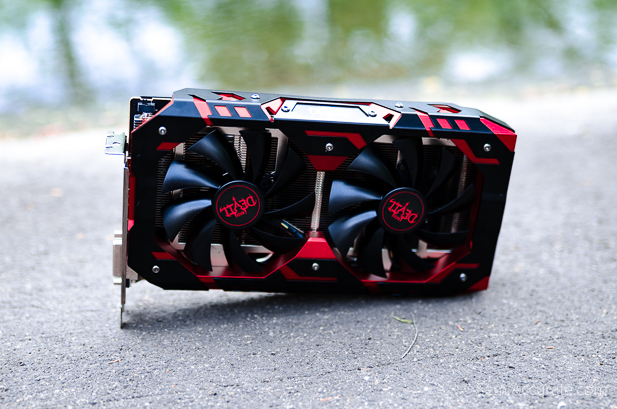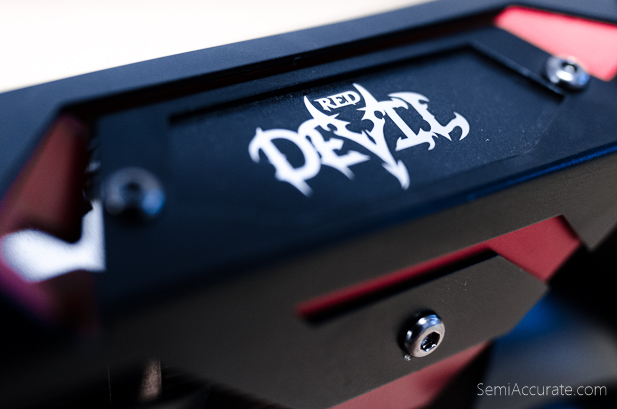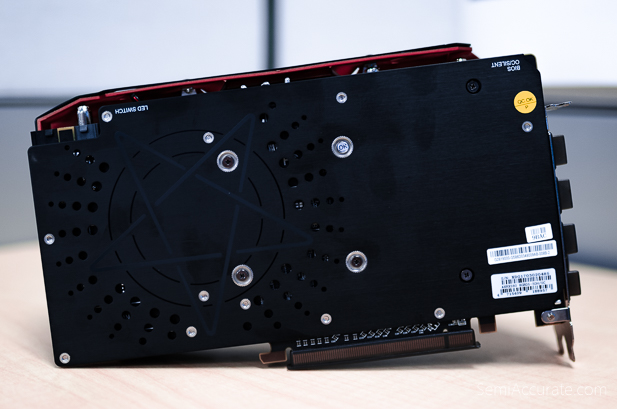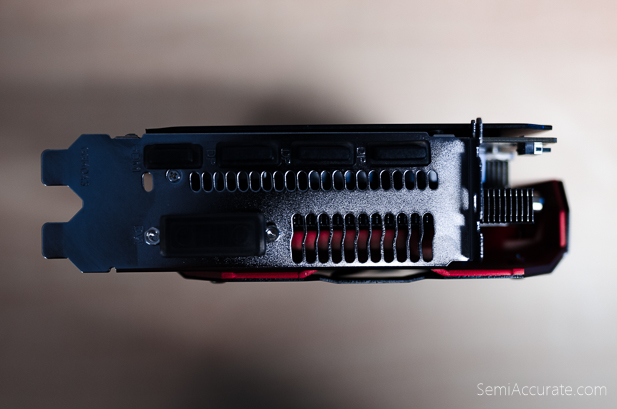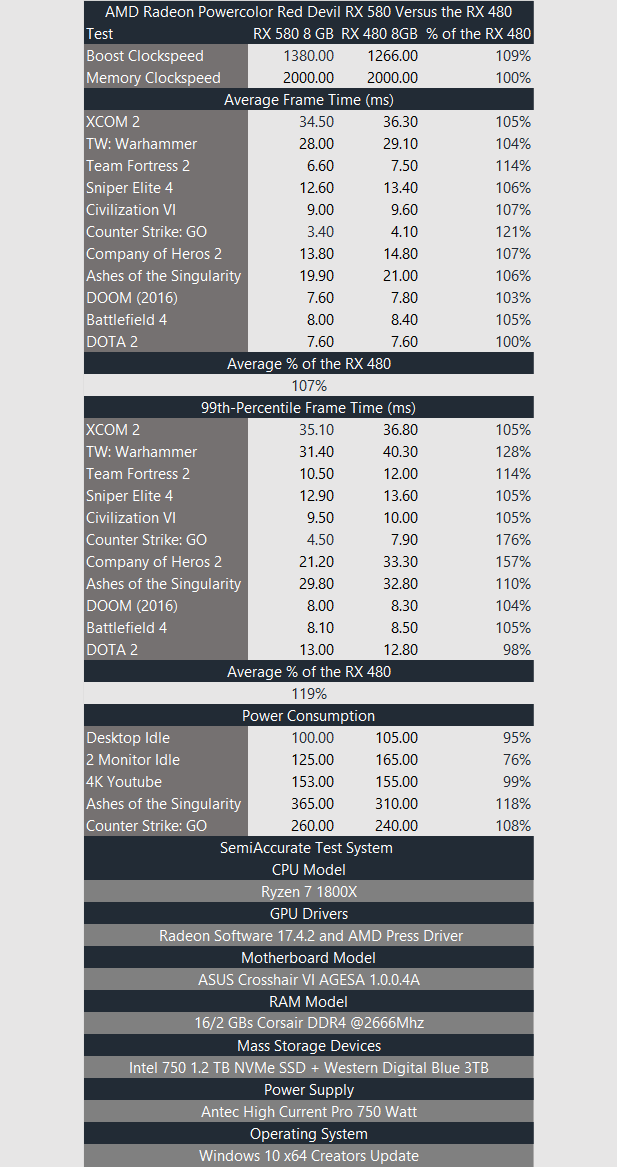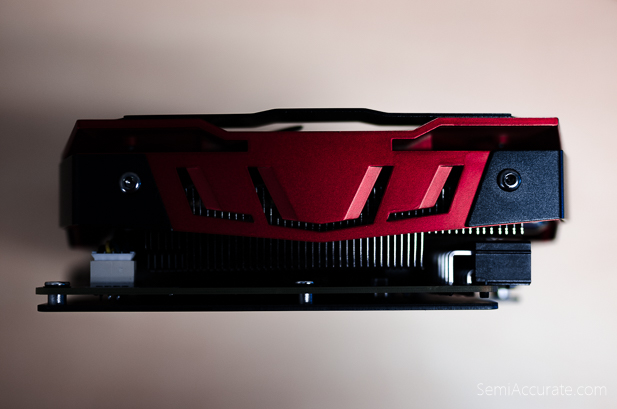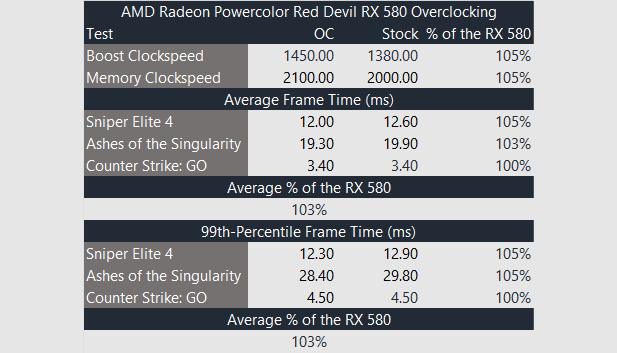Today AMD is hard launching the Radeon RX 580 and RX 570. These two products are based on the Polaris 20 chip which is a mildly updated version of AMD’s old Polaris 10 chip. The new RX 580 and RX 570 replace last year’s RX 480 and RX 470 products while extending their range into higher performance segments of the market than those chips occupied. Unlike the Radeon RX 4xx series, AMD is bringing the RX 5xx series to market without a reference design. Rather AMD’s AIB partners are offering custom designed SKUs like the Powercolor Red Devil RX 580 8GB we’ll be reviewing in this article.
Not A Rebrand Per Se
According to AMD this isn’t just a straight re-branding of the RX 400 series. Based on our testing we believe them. First up AMD’s improved the power consumption profile of its RX 500 series products most notably in desktop idle and multi-monitor scenarios. Thanks to a year’s worth of 14nm FinFET process improvements and better binning the RX 580 is also clocked a bit higher than the old RX 480. Because AMD’s partners are coming to market with custom designs the specific number is variable but our RX 580 sample is clocked at 1380 Mhz which is 9% boost over the reference RX 480 we tested last year. AMD has also improved memory clock-speeds by 14% from 1750 Mhz on the ‘reference’ RX 480 to a cool 2 Ghz on our RX 580.
While this is a bigger improvement than what we saw during the R9 2xx to R9 3xx transition it’s still a pretty mild performance advancement. This is especially true when it comes to memory clock speeds which on most RX 480’s is already at 2 Ghz. The reality of the situation is that we’re still waiting for AMD’s Radeon RX Vega to significantly upset the graphics market. The impact of AMD’s RX 500 series on the existing pricing stack is minor.
If you own a RX 480 or RX 470 you have no reason to be covetous of these new RX 500 series graphics cards. This is why AMD is once again pitching its new graphics cards as a good upgrade from older 200 and 300 series GPUs.
Radeon Chill
AMD is also pushing its Radeon Chill feature pretty heavily. This feature caps the rendering rate of your GPU to your monitor’s refresh rate and then scales that cap up and down based on your inputs for in-game movement. If you stand still the cap will drop to 30 FPS and if you start moving it will rise up to your monitor’s maximum refresh rate. This technology works using per game profiles so you’ll need to check if the game you’re thinking of is supported.
The advantages of enabling Radeon Chill are three-fold: reduced power consumption, reduced GPU temperatures, and reduced input latency. Power consumption and temperatures are reduced by not loading the GPU down with work constantly. Input latency is reduced by limiting the rendering rate to the refresh rate, which has the effect of getting slightly fresher frames to your eyes than you would see in an uncapped scenario.
Given that Radeon Chill was written on a third of the slides in the RX 500 series deck we asked AMD if they had any plans to enable it by default. They don’t, but they are hopeful that somewhere down the line they’ll be able to offer something like Radeon Chill for use on a wider array of games. In the meantime, AMD has acknowledged that the button to enable this feature is kind of buried inside of the WattMan panel of Radeon Settings.
AMD Radeon RX 580 Benchmarks
Our primary performance data capturing tool is OCAT. This is a tool that was released as part of AMD’s GPUOpen effort last year and is much more usable than FRAPS or in-game performance queries. We’ll be looking at three metrics to compare these GPUs: Average Frame Time, 99th-Percentile Frame Time, and per Scenario Power Consumption. In all of these metrics the lower the score the better. It’s also worth noting that we used the most modern graphics APIs offered by the individual game like the Vulkan branch of DOTA2 or Sniper Elite 4’s DirectX 12 branch.
The whatever AMD’s done to enhance the RX 580 it seems to have a bigger impact when we look at 99th-Percentile frame times than at average frame times. We see large improvements in Counter-Strike: GO, Company of Heroes 2, and Total War: Warhammer. In other games, the improvement in 99th-Percentile performance is in line with the modest gains we’re seeing in average frame times.
Looking at the bigger picture we can see the RX 580’s performance scales in a nearly linear fashion with its clock speed boost over the RX 480. Given the lack of major architectural changes between Polaris 10 and 20 this should come as no surprise.
Reviewing our power consumption data we can see that the Radeon Technologies Group has made big strides in reducing power consumption in desktop idle scenarios with both single and dual monitor setups. Of course with higher clock speeds comes greater power consumption and the RX 580 clearly draws a bit more power under load than the RX 480. Worth noting at this point that these are full system power consumption numbers that are measured at the wall, and not GPU isolated consumption.
Overclocking the AMD Radeon RX 580
On our RX 580 sample, the maximum voltage we could set was 1200 mV for both core and memory. We also bumped the power limit up to +50% to avoid limiting our results and left the fan settings untouched.
While our RX 580 certainly clocks higher than the reference RX 480, dreams of breaking the 1500 Mhz barrier are a bridge too far. The memory overclocked well enough reach frequencies of up to 2200Mhz, but as is often the case with GDDR5, performance was better at 2100 Mhz.
With a 5% boost to core and memory clock speeds, we see an almost linear gain in performance. Counter-Strike: GO was unaffected, but we were already seeing excellent performance in this game with the stock RX 580.
Another year and another RX
Today we have the launch of the AMD Radeon RX 580. It’s a mild update of last years RX 480 that improves core clock speeds and enables slightly higher performance levels. Taken completely out of context the RX 580 is a good product. But it’s release isn’t going to have much impact on the market and the improvements it offers are disappointing given how much time that the Radeon Technologies Group has had to refine the Polaris architecture. Clearly, when the RX 480 launched last year AMD already was playing every card it had.
In the end, the RX 580 is a solid refinement of a well-known product. AMD’s partners seem to have perfected their custom designs with quiet coolers and robust power delivery systems. AMD was smart to skip out on a reference design for this update. Hopefully, the Radeon Technologies Group will continue to enable their AIB partners to build the best products with the upcoming RX Vega lineup. It would be a shame to see a repeat of the RX 480 launch with a month-long gap between the availability of reference and partner designs.
On a slightly more somber note, the launch of the RX 580 means that we probably won’t be seeing a version of Vega that slots into this market segment in the next year. Vega is set to be a purely high-end offering. This isn’t really a surprise but it is an interesting choice given how significant the changes between Polaris and Vega appear to be.S|A
Thomas Ryan
Latest posts by Thomas Ryan (see all)
- Intel’s Core i7-8700K: A Review - Oct 5, 2017
- Raijintek’s Thetis Window: A Case Review - Sep 28, 2017
- Intel’s Core i9-7980XE: A Review - Sep 25, 2017
- AMD’s Ryzen Pro and Ryzen Threadripper 1900X Come to Market - Aug 31, 2017
- Intel’s Core i9-7900X: A Review - Aug 24, 2017
